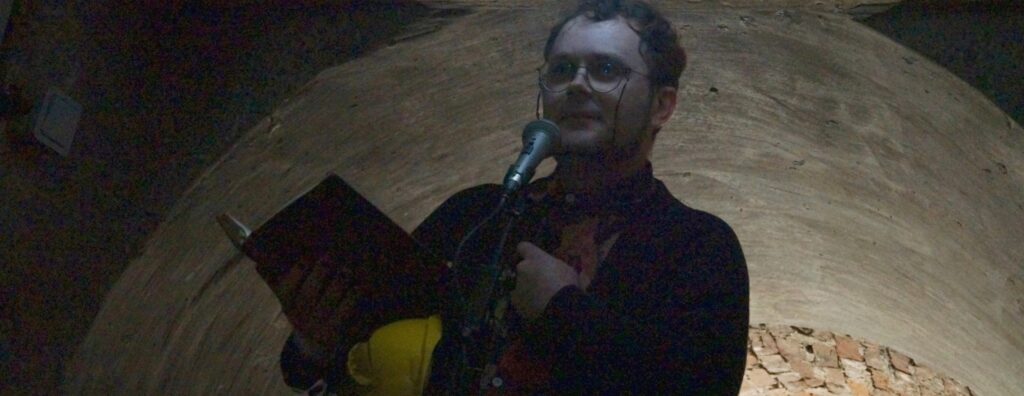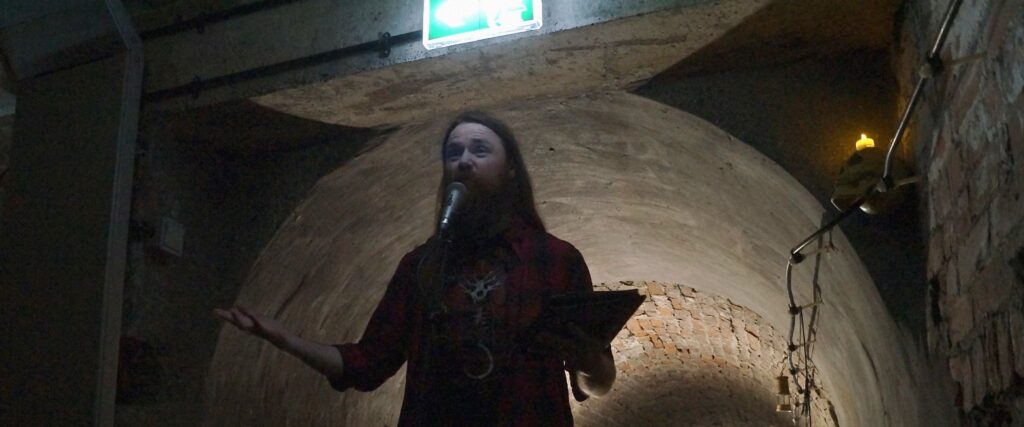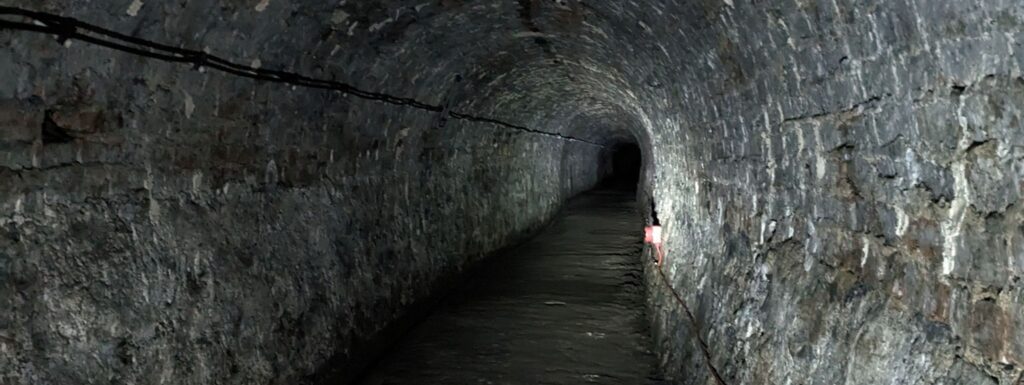If you’d asked me last September, I wouldn’t have said I was a history nerd. But that was before I happened upon a strange metal door, that led me down into the tunnels beneath the city’s storied streets…
It came through an opportunity presented by the Ouseburn Trust. They were looking for performers to host events in the Victoria Tunnel, and I jumped at the opportunity to bring poetry to such a unique venue! I teamed up with Mark Gallie to host an evening of sinister stanzas and classic ghost stories, and thus Terror in the Tunnel was born.

It was an amazing night. Almost fifty people filed their way down into rows of seats, two-by-two down the first stretch of the tunnel. Then opposite them, a microphone, set up careful to ensure none of the cables dipped into the channel of water flowing along the side of the tunnel. If that sounds like an unusual space for a performance, it was! But the atmosphere was incredible, as was the audience. Not to mention the echo!
And the rest is history, quite literally! That’s the part the really snuck up on me. I knew it would be exciting to perform underground in an 180-year old tunnel, but I didn’t expect to find so much inspiration in the guided tour I went on in preparation for the event.
It covered the entire lifespan of the tunnel, from its innovative construction and use moving coal from Leazes Colliery to Newcastle Quayside in the 1800s, to its time as an air raid shelter during World War Two, and the tragic incidents that occurred there after its original closure. The volunteers who ran the tour were so in touch with the history of the place and such good storytellers, I couldn’t help but be captivated! It was a wonderful dive into not just the cultural heritage of the Ouseburn Valley, but of Newcastle and the North as well.

So applied what I had learned in my previous residency and got to work writing about what I saw around me, with the aim of helping others engage with local history in the same way the tour guides had helped me.
Except this time it wasn’t paintings – it was personal! Because you see, it turned out I had a family connection to the place. Perhaps a tenuous link, but when I mentioned the tunnel to my family, they asked if they’d ever told me about my ancestor Freda Audry Brown and her recipe for pickled mushrooms. What a question! Apparently her father had been a coal merchant with a warehouse that was connected to the tunnel. The saddle keeper who lived on the premises used to grow mushrooms down there, and Freda would buy and pickle them! The recipe doesn’t survive, but apparently the secret ingredient was mace, which is a name for the outer skin of nutmeg.
My father had also been reading an article by Historic England about Kinetic Views; locations where the fact that they are often seen in motion (i.e. while walking on foot or taking a train) is an important part of what makes them architecturally significant. Newcastle Quayside and the Tyne’s many bridges are both good examples, and I couldn’t help think the curving walls of the Victoria Tunnel were another.

Those two notions turned into a poem and a short story that would be load-bearing pieces of the show. That idea of kinetic views became the opening poem; History in Motion. I’m pretty happy with how that one turned out, and you can read it here on the Ouseburn Trust’s website.
The mushroom story became something more like a ghost story, which you can read right here! It’s called Mycelium:
Mycelium
Everyone assumed he was growing mushrooms for pickling.
That’s what the old saddle keeper did. He’d cart horse manure down from the Ouseburn stables up above into the disused tunnel underneath. Then he’d sell the mushrooms to the owner’s daughter and she’d preserve them with extract of nutmeg. But the new owner never produced any, well, produce to show for his efforts.
He called himself a natural scientist, although no one really knew what that meant. Given to expeditions to the Americas in his youth, where apparently he’d once found something quite remarkable, so why on earth (or under it) he had decided to pack all that in and buy property in Newcastle was anyone’s guess. Something about ‘mycology’…
The stables were still there, and he bought up all the manure. From the surrounding stables too. And all of it went down the tunnel, along with other, stranger things. Jars of powdered nutrients. Unmarked crates from overseas. Swarthy workmen. Sturdy shovels. A lame horse.
Sold off to the glue factory, everyone said. Down the tunnel, everyone thought.
All that, and nothing of value ever came out. Except the owner, and that was less and less often. He complained of the sun, which was ridiculous. In Newcastle? What sun? And he hardly looked a man of means with his clothes always smelling of mildew and a curious dust always falling from his hair. And from the cracks in his clothes. And even from his hands when he moved them, which he would in nervous, hunted, hungry motions, always impatient to get back to premises. To get back beneath his premises.
“Duty calls! Duty calls. Duty growing in the walls.”
Quite mad, they were all sure. But harmless, harmless. Until it was a child that vanished. Snuck out to play with her friends by the Ouse – the River Ouse, not the substance seeping up through the cellars of the half the town – and while she was out there something grabbed her. The other children sobbed hysterically about a shape, rising from the muck of the riverbed. Rubbery, elongated arms. Twisted faces. An otherworldly song, laboured, breathless, wordless, tuneless but sweet like cordyceps.
That last part they pieced together later, to explain why the child hadn’t run. But first, they had a mob to put together. The kind that builds, like an avalanche with boots, each voice urging on the others because if anyone stops for too long then anger will curdle into fear.
None stepped out to stop them, as they stormed the stables, into the warehouse, cascaded past glass lab equipment smashing as they went, then down into the basement, then down into the tunnel, then down, down, down further than it was ever known to go, brushing aside great thick spongy strands that only resembled cobwebs if you squinted.
That’s where they found the mass, and heard the madman’s sermon.
“Don’t you see?” he hissed in rapture, “We are but fruiting bodies, we were never meant to propagate, to spread across the world, sowing division and fear and hate. Separation will be the end of us, I have seen it, I have seen it in the spores!”
And that’s when they saw his face, the eyes gone, replaced with a lattice of white pulsating threads that travelled outwards, upwards, interweaving with the fungus that grew in great fecund sheets from the walls and the ceilings and the floors where a dozen other bodies were entwined, entombed, become a part of the whole, lungs gone but mouths calling out “join us, join us, join us”.
They threw his body on the bonfire with the others, and called it done. No one wanted to go back down there. Eventually they decided to flood it, and sealed it off, like they tried to do with the memories of what they had seen.
But no matter how much time had passed, no matter how far they travelled, the madman’s vision had found the dark and fertile corners of their minds and settled like a spore. And one, by one, they each of them returned, and went into the tunnel.
Mycelium (2024), Lewis Brown
Happy Halloween!
